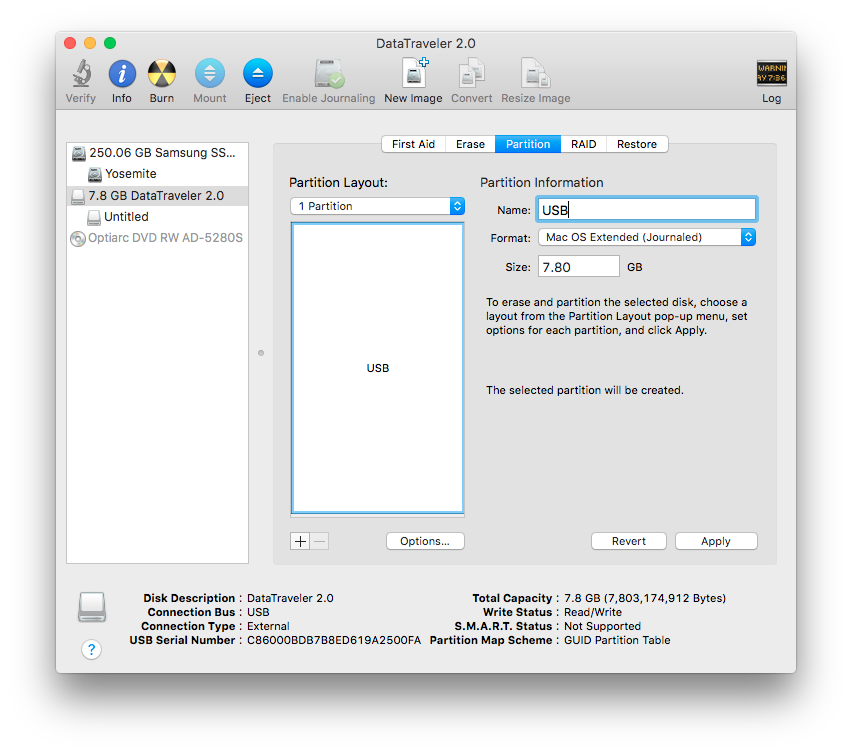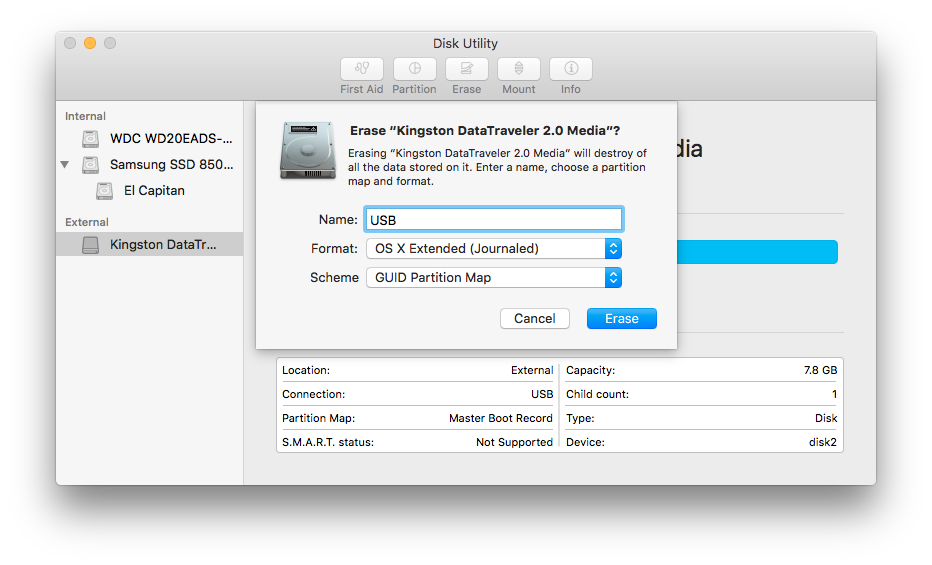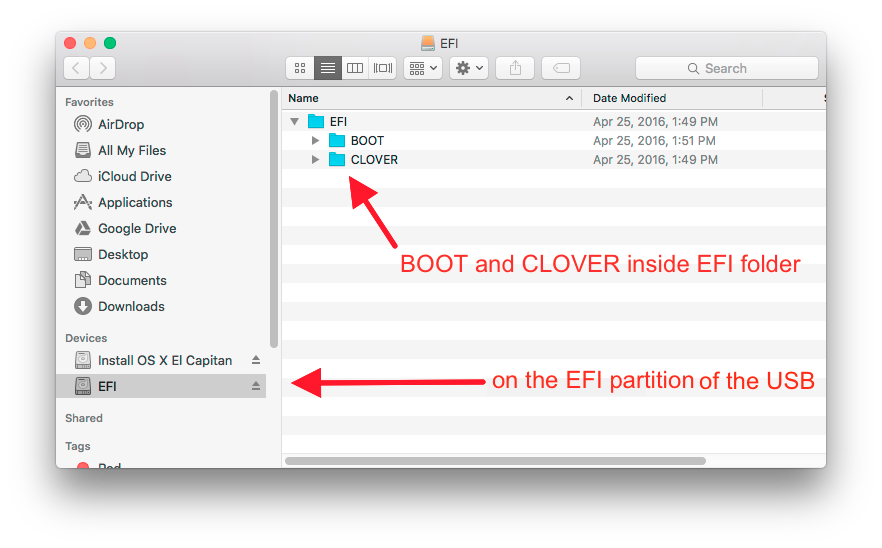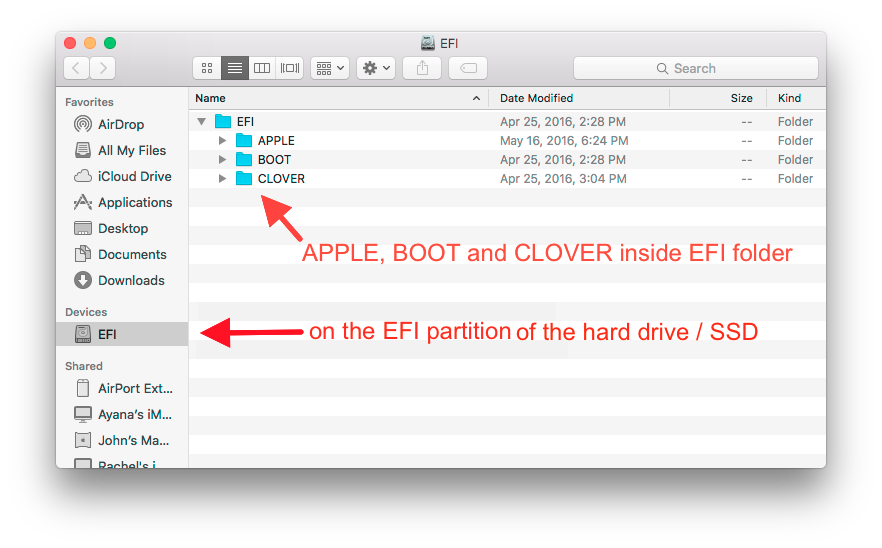This guide is no longer being updated.
See the ThinkPad X220 Mojave guides hereThinkPad X220 OS X 10.11 El Capitan Installation Guide
Follow these steps to perform a clean installation of OS X 10.11 El Capitan on your ThinkPad X220 or X220 Tablet.
- Videos demonstrating OS X 10.11 El Capitan running on the X220 can be viewed here and here.
- If you already have OS X 10.10 Yosemite on your X220 we recommend doing a clean installation of El Capitan, not an update from the existing installation.
- See the guide here to install OS X 10.10 Yosemite on the ThinkPad X220.
- See the guide here to dual-boot OS X and Windows.
- Please use our contact form if you find anything that isn’t accurate.
PART 1 of 4: ADJUST BIOS SETTINGS
- Install the modified BIOS version 1.46 to remove the whitelist check and permit the installation of a Wi-Fi card compatible with macOS. This modified BIOS will also enable advanced settings and improve battery life under macOS.
– MD5: 4a769c4f17e8aa0dc0e6927ebe75635d
– To install this modified BIOS from a bootable USB drive, see the instructions here.
– Please note the warning on the Advanced menu in the BIOS: Setting items on this screen to incorrect values may cause the system to malfunction! The default values will work fine but the wrong settings can prevent your X220 from booting.
Wi-Fi card recommendations:- Stock Wi-Fi cards in the X220 are not compatible with macOS
- Wi-Fi cards that require no configuration whatsoever and will work automatically in macOS:
- Dell DW1510 – 802.11a/b/g/n 2.4 GHz & 5 GHz (Broadcom)
or - Dell DW1515 – 802.11a/b/g/n 2.4 GHz & 5 GHz (Atheros)
- Dell DW1510 – 802.11a/b/g/n 2.4 GHz & 5 GHz (Broadcom)
- For 802.11ac + Bluetooth as well as Continuity/Handoff support, it may be possible to make the AzureWave AW-CE123H (aka Dell DW1550) card work by following the steps in the guide here. Another guide that might be helpful is available here. Note that it will not be possible to boot from our standard USB installer with this card installed; only install this card after the macOS installation is complete and the necessary modifications have been made.
- Various other Mini PCIe and USB Wi-Fi adapters compatible with macOS are listed here
- Press F1 at startup to set the BIOS settings as follows:
– Restart > Load Setup Defaults
– Config > Power > Power On with AC Attach > Disabled
– Config > Serial ATA (SATA) > SATA Controller Mode Option > AHCI
– Security > Memory protection > Execution Prevention > Enabled
– Startup > UEFI/Legacy Boot > Both
.
PART 2 OF 4: CREATE USB INSTALLER
. - Download the Install OS X El Capitan app from the App Store
- Insert an 8GB or larger USB disk
- Open Applications > Utilities > Disk Utility
If you are using Disk Utility under OS X Yosemite or earlier:
– Select the USB disk in the left pane and select the Partition tab
– Select Partition Layout and then choose 1 Partition
– Select Options… and select GUID Partition Table
– Under Name: type USB
– Under Format: select Mac OS Extended (Journaled)
– Click Apply and then Partition
 If you are using Disk Utility under OS X El Capitan:
If you are using Disk Utility under OS X El Capitan:
– Select the USB disk in the left pane (select the physical disk, not a volume on the disk)
– Click the Erase button
– Under Name: type USB
– Under Format: select Mac OS Extended (Journaled)
– Under Scheme select GUID Partition Map
– Click Erase

- Open Applications > Utilities > Terminal and enter the following command:
sudo /Applications/Install\ OS\ X\ El\ Capitan.app/Contents/Resources/createinstallmedia --volume /Volumes/USB --applicationpath /Applications/Install\ OS\ X\ El\ Capitan.app --no interaction
- Enter your password when prompted
- After approximately 25-35 minutes the process will finish and the USB will be renamed Install OS X El Capitan (wait for the “copy complete” message in the Terminal before continuing)
- Download the ThinkPad X220 OS X El Capitan Utility and Kext Pack and place a copy on your installation USB
- Launch Clover Configurator from the Utility and Kext Pack and click the Check Partition button to identify the disk number of assigned to your USB (it will probably be /dev/disk1 or /dev/disk2)
- Click the Mount EFI partition button and select the disk number of your USB as identified in the previous step (the disk number will be followed by s1, for example disk1s1)
- Quit Clover Configurator and copy the entire EFI folder from the Utility and Kext Pack to the EFI partition of your USB, replacing the existing folder if present.
The EFI partition on your USB should now contain a single folder named EFI that contains two folders: BOOT and CLOVER. It should look like this:

- Eject your USB
.
PART 3 OF 4: INSTALL OS X 10.11 EL CAPITAN
. - Disconnect any external monitors or other devices and place the USB drive in a USB 2.0 port of your ThinkPad X220. Press F12 at startup to select the USB as your boot drive
- Use the arrow keys to select Boot OS X Install from Install OS X El Capitan at the Clover bootloader menu and press Enter
- Select your desired language, launch Disk Utility then select your target drive and click Erase
- Name the target drive Macintosh HD, select OS X Extended (Journaled) format, GUID Partition Map scheme and click Erase
- After the erase process finishes, quit Disk Utility, select Install OS X and follow the prompts to do a standard OS X installation on Macintosh HD
- The install process may appear to hang at the end with “About a second remaining.” Just wait – it may take up to an hour finish (if the screen dims you can press a key to wake it)
- The computer will eventually restart. When it does, press F12 to select the USB as your boot drive and then select Boot Mac OS X from Macintosh HD at the Clover bootloader menu.
(If Macintosh HD does not show in the menu just select the Install OS X El Capitan drive again – the installer sometimes triggers a reboot to complete the installation process) - Complete the guided OS X setup
.
PART 4 OF 4: POST INSTALL
. - Go to System Preferences > Security & Privacy and select Allow apps downloaded from: Anywhere
- Launch Clover Configurator from the Utility and Kext Pack and click the Check Partition button to identify the disk number of Macintosh HD (it will probably be disk0)
- Click the Mount EFI partition button and select the disk number of Macintosh HD as identified in the previous step
- The EFI partition for Macintosh HD should now be mounted and show in the sidebar under Devices when you open a Finder window
- Quit Clover Configurator
- Copy the folders named BOOT and CLOVER from the EFI folder in the Utility and Kext Pack to the EFI folder on the EFI partition of Macintosh HD.
The EFI partition should now contain a single folder named EFI that contains three folders named APPLE, BOOT and CLOVER. It should look like this:

- Open Utility and Kext Pack > EFI > CLOVER > kexts and launch the script entitled _kext-install.command
- Enter your password when prompted and wait for the script to install the kexts
- Eject the installation USB and restart the computer
- Install any El Capitan system updates available from Apple through Software Update and take a moment to read through the Notes and Suggestions section below
- Recommended additional steps to improve battery life with optimized CPU power management:
- Confirm that you have an active connection to the Internet
- Open Applications > Utilities > Terminal then copy and paste the following command in the Terminal window and hit Enter:
curl -o ~/ssdtPRGen.sh https://raw.githubusercontent.com/Piker-Alpha/ssdtPRGen.sh/master/ssdtPRGen.sh
- Next, paste this command in the Terminal window and hit Enter:
chmod +x ~/ssdtPRGen.sh
- Finally, paste this command in the Terminal window and hit Enter:
./ssdtPRGen.sh
- Answer ‘N’ to the questions about copying and opening the ssdt files
- A customized SSDT.aml for your specific machine will now be in the /Users/yourusername/Library/ssdtPRGen directory
(quickly access this directory in the Finder by holding the Option key (Windows key) while selecting the Go menu and then selecting Library) - Copy SSDT.aml to /Volumes/EFI/EFI/CLOVER/ACPI/patched/
(you may need to run Clover Configurator to mount the EFI partition) - Run the Kext Utility app to repair permissions and rebuild the system cache, then restart the computer
Notes and Suggestions
- User Reviews of this Guide
- Fair Logic’s video demonstration on YouTube – September 3, 2016
- Pyroisonfireee’s review on Reddit – June 24, 2016
- imtony’s video demonstration on YouTube – March 15, 2016
- General Suggestions
- Do not encrypt your boot drive with FileVault. Doing so will prevent the system from booting correctly.
- Keep your El Capitan installation USB on hand. After installing OS X system updates it is sometimes necessary to boot the system with the USB and re-install kexts to get everything working properly again.
- Use Clover Configurator if you need to mount the EFI partition
- Using Clover Configurator to edit the default config.plist is not recommended. This program will automatically and without warning makes changes to the default settings in the <key>ACPI</key> section that will prevent the system from booting. If edits are needed, open config.plist with TextEdit and follow the format explained here.
- If a kernel panic occurs, boot from the installation USB, select the installation drive, hit the space bar and select Boot Mac OS X in safe mode to successfully boot and make necessary changes.
- Touchpad, TrackPoint and Tablet Input
- Touchpad and TrackPoint use RehabMan’s VoodooPS2Controller.kext found here.
- Turn off the touchpad with the <PrtSc> key if you will only be using the TrackPoint – this will prevent an issue with unintentional double-clicks with the TrackPoint buttons.
- Touchpad supports three-finger swipe right and left (forward and back) in Finder, Safari and other browsers
- For X220 Tablet models, pen input should already work properly. For touch input, install ControllerMate and use the script written by user jakibaki available here. Jakibaki’s script also adds some gestures including swipe from top to get Mission Control, swipe from bottom for Launchpad and swipe from left/right to switch workspaces.
- Special Keys
- The <PrtSc> key toggles the touchpad on and off
- The <ScrLk> and <Pause> keys adjust screen brightness as do the standard <Fn>+<Home> and <Fn>+<End> keys
- The <Insert> key will eject the CD/DVD drive (attached by USB or docking station)
- The blue ThinkVantage button will toggle between normal fan speeds and the maximum fan speed
- Fan Speed and Noise
- Fan speeds can be reduced by installing the alternate dsdt.aml and ACPIPoller.kext available here
- Fan noise can also be regulated by changing the BIOS setting under Config > Power > Adaptive Thermal Management to Balanced
- Video / External Displays
- To enable scaled resolutions of 1536 x 864 and 1920 x 1080 on the stock LCD panel, follow the steps here
- Video output through VGA, DisplayPort and docking stations works normally for single external monitor configurations (internal LCD + one external monitor)
- If an external monitor is not automatically detected, open System Preferences > Displays and press the Option key (the Windows key on the X220 keyboard). This will show a Detect Displays button which should make the external monitor show up immediately.
- If DisplayPort or VGA connections on Core i7 systems do not function properly:
- Launch Clover Configurator and mount the EFI partition of your installation drive
- Click File > Open… then select EFI > EFI > CLOVER > config.plist
- Select SMBIOS in the left panel and click the “magic wand” button on the right
- Select the MacBook Pro image (second image from the left) and then select MacBook Pro (8,1) – Core i5/i7 (Sandy Bridge) from the pulldown menu at the top
- Click the OK button and then File > Save to write the changes to your config.plist
- Restart the computer
- Miscellaneous
- To enable docking station headphone and microphone ports, use the alternate AppleHDA_20672.kext available here. Simply place this alternate version in Utility and Kext Pack > EFI > CLOVER > kexts > Other and repeat steps 28-30 above.
- DW1510 wireless cards can be rebranded to identify as native Apple AirPort Extreme cards by following the steps here
- SuperDuper is an excellent free utility to create a full, bootable backup of your drive that can be restored later if necessary. Follow the steps here to make your backup bootable.
- HWSensors provides a convenient way to monitor the status of your system from the menu bar
- Smart Scroll can be installed to enable middle-button TrackPoint scrolling even when the touchpad is disabled
- Ukelele can be installed to create customized keyboard layouts
- If the Bluetooth radio is turned off in Windows or Linux it may no longer show up when booting into OS X. Boot back into Windows or Linux to turn the Bluetooth radio back on.
- If FaceTime or Messages (iMessage) does not work correctly, follow the steps in the guide here
- Custom “OS X220” desktop wallpaper by user Will is available here
- Sources / Credits
- Not functioning
- SD Card reader
- Fingerprint reader
- Microphone mute button
OS X EL CAPITAN UPDATES
- Security Update 2016-001 10.11.6 – installs with no issues.
- OS X El Capitan Update 10.11.6 – installs with no issues.
- OS X El Capitan Update 10.11.5 – installs with no issues.
- OS X El Capitan Update 10.11.4 – installs with some issues. Download the updated Utility and Kext Pack and repeat steps 24 – 31 to remedy issues with graphical artifacts and audio. Credit to tluck at insanelymac.com for the solutions to these issues.
- OS X El Capitan Update 10.11.3 – installs with no issues.
- OS X El Capitan Update 10.11.2 – installs with no issues.
- OS X El Capitan Update 10.11.1 – installs with no issues.
INSTALLATION GUIDE UPDATES
- 08/05/2018: Updated Utility and Kext Pack with new versions of Clover Configurator (5.1.5.0) and Kext Utility (2.6.6)
- 06/28/2018: Updated link to latest version of modified BIOS v1.46 source
- 06/06/2018: Updated link to latest version of modified BIOS v1.45 source
- 11/22/2016: Updated link to latest version of modified BIOS
- 09/20/2016: Posted new installation guide for macOS Sierra
- 08/13/2016: Updated steps 2 and 3 for new version of modified BIOS that allows security chip to be enabled
- 08/10/2016: Added information under Notes and Suggestions to enable touch input on tablet models
- 07/13/2016: Posted guide to installing macOS Sierra Public Beta 10.12
- 06/17/2016: Updated steps 1 and 2 for new version of modified BIOS
- 04/22/2016: Added guide to rebrand DW1510 cards as AirPort Extreme
- 04/16/2016: Updated Utility and Kext Pack to include a kext installation script and new Clover config.plist to address issues with 10.11.4 update
- 03/24/2016: Updated Utility and Kext Pack to include new version of AppleHDA_20672.kext
- 02/06/2016: Added note to step 3 regarding BIOS setting for VT-d Feature
- 01/31/2016: Updated Utility and Kext Pack to include GenericUSBXHCI.kext to enable USB 3.0 on Core i7 systems. Pack also updated with a new version of VoodooPS2Controller.kext for improved trackpad performance
- 12/30/2015: Updated link in step 2 to improved version of modified BIOS
- 11/04/2015: Corrected an issue with the config.plist in the Utility and Kext Pack that could interfere with the boot process
- 11/01/2015: Updated AppleHDA_20672.kext in Utility and Kext Pack to enable headphone port on dock; added BroadcomBluetooth.kext to enable Bluetooth power on/off
- 10/31/2015: Modified Utility and Kext Pack to remove extraneous audio kext from EFI folder
- 10/30/2015: Modified Post Install steps due to issues with Clover not installing to the EFI partition of the target drive for some users
- 10/27/2015: Initial version of guide posted

